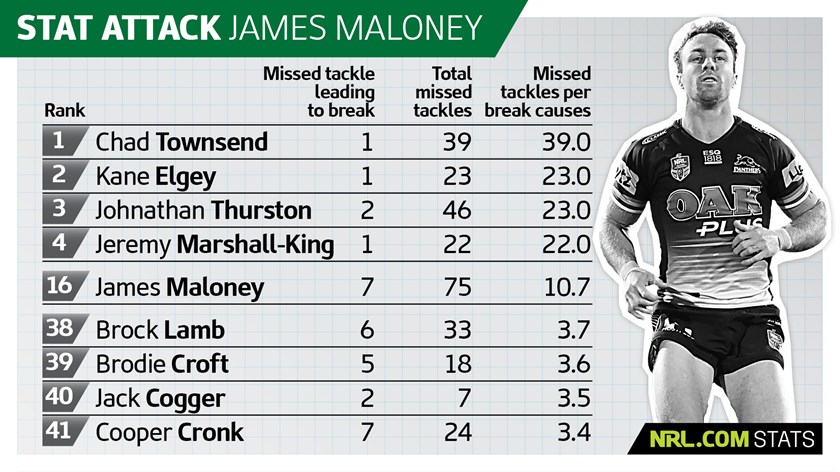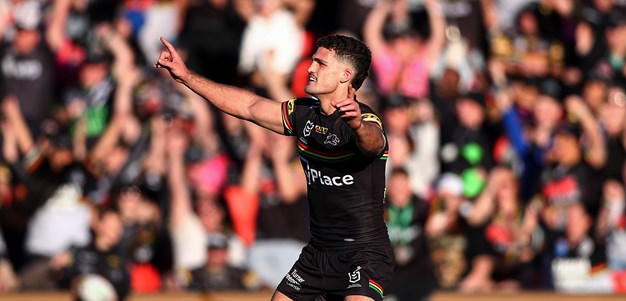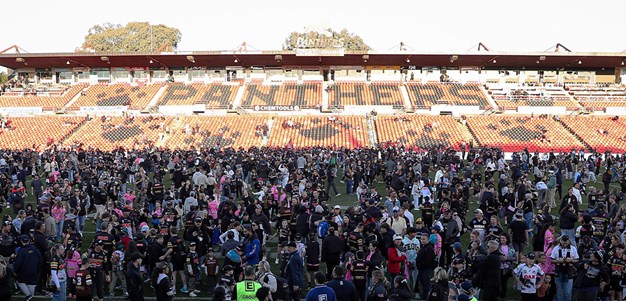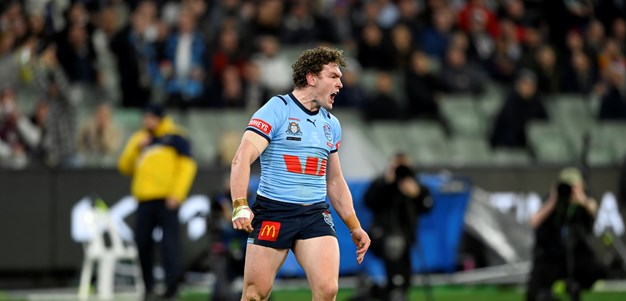There has been a narrative lately that James Maloney's defence is worrying the NSW Blues hierarchy ahead of the selection of teams for Origin I.
But is he that bad?
NRL.com Stats have recorded 75 missed tackles for Maloney this season – 150% of the tally of the next worst, Wests Tigers back-rower Robbie Rochow (51), with Luke Brooks and Mitch Moses in equal third on 47.
Firstly, what is a missed tackle? It's not always getting trampled over by a rampaging ball carrier who sprints off into space. It is any contact by a defender on a ball carrier in an attempt to make a tackle in which that contact is then broken.
What this means is that if a centre runs into Maloney, who braces, and bumps off the ball carrier, halting his momentum, and the runner is then fallen on by Dean Whare without taking another step, Maloney earns a missed tackle even though he's done his job.
It turns out this happens to Maloney a lot. See the video below for a list of examples. The vast majority of Maloney's series-high 22 missed tackles in the 2017 Origin series were inconsequential fends or bumps as well.
Maloney’s missed tackles aren’t always costly
Of course, there are other times when a runner genuinely shrugs Maloney off and makes a break or scores a try. This happens to all edge defenders.
A better metric for analysing a player's defensive frailties involves try causes and break causes. In try causes, Maloney's nine is equal 13th-worst in the NRL and equal second-worst among halves behind Daly Cherry-Evans (12).
Break causes is where Maloney struggles – his 16 are an NRL high. Among halves, Raider Blake Austin (14) and Rooster Cooper Cronk (13) then Cherry-Evans (12) are all just behind him.
Often what this suggests is that edge is being targeted and certainly the opposite halves at those clubs in players like Aidan Sezer (four break causes), Luke Keary (three break causes) and Lachie Croker (three break causes in eight games) are well down on the break cause and try cause lists.
In this analysis, NRL.com Stats has attempted to break down the costliness of halves' misses and found Maloney's missed tackles aren't overly expensive. Of his 75 misses, seven contributed to opposition breaks, or one every 10.7 misses – meaning plenty of inexpensive misses (other misses are still not ideal if they bring another player out of the defensive line to help out but are much easier to recover from).
Top of the tree is Maloney's former Cronulla halves partner Chad Townsend whose 39 season misses have only led to one line break. Johnathan Thurston is another whose misses rarely prove costly and maligned Eels playmaker Mitch Moses is another who may miss a few but doesn't contribute to a stack of breaks – even more notable given his team's defensive woes elsewhere.

Worst of the regular halves in this category is Rooster Cooper Cronk, who was something of a defensive maestro for years on the right edge at the Storm. What this tells us is the new defensive structures around him at the Roosters have taken some time to get right with Joey Manu getting swapped for Mitch Aubusson a few weeks ago.
Newcastle's Brock Lamb and Gold Coast's Ash Taylor are another two who may have fewer missed tackles than Maloney but the same number of misses leading to breaks, making their respective misses more costly on average than Maloney's.
In conclusion – Maloney may be one of the weaker defensive halves in the NRL in certain metrics but his apparently shocking amount of missed tackles are deeply misleading. His team has conceded the second-fewest points of any club (and just three points more than the Dragons) and he generally is prepared to get his body in front, even if he poor at "hitting and sticking". To an extent his defensive weaknesses are also balanced out by what he brings in attacking play, leadership, experience and decision-making. It would be a massive call to overlook him for Origin based on his missed tackle tally.








